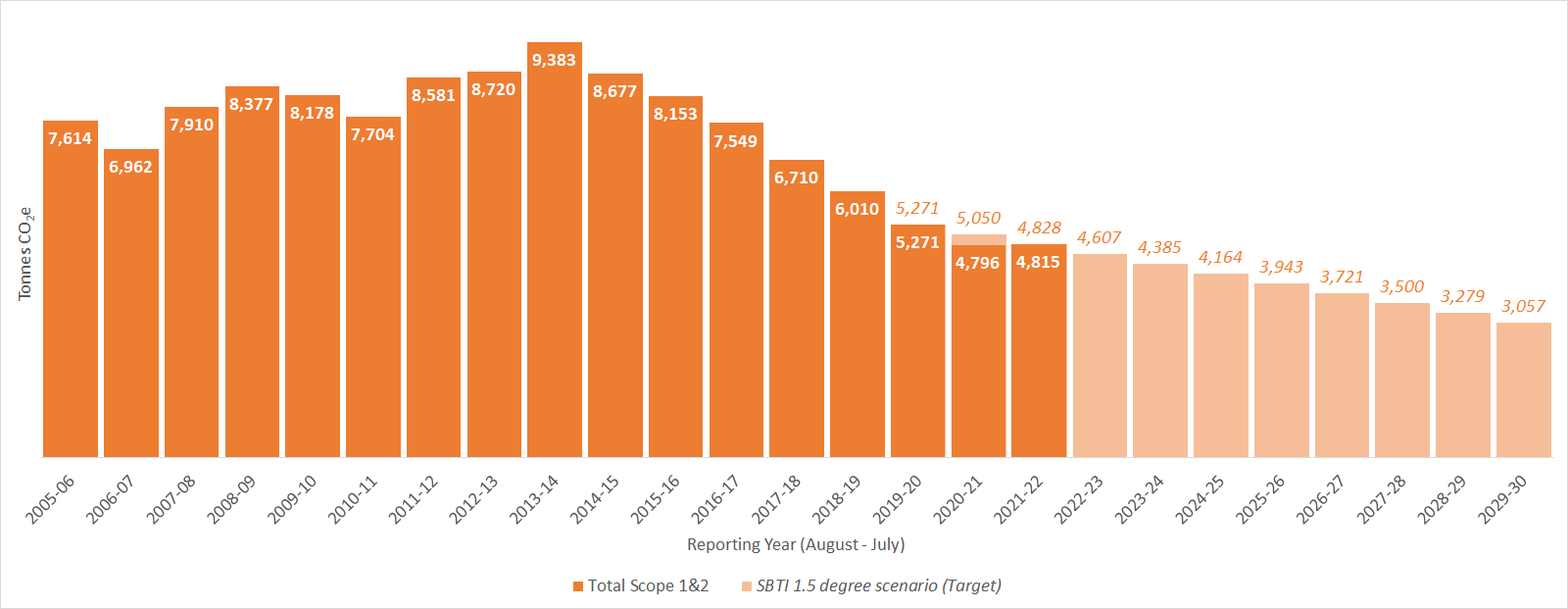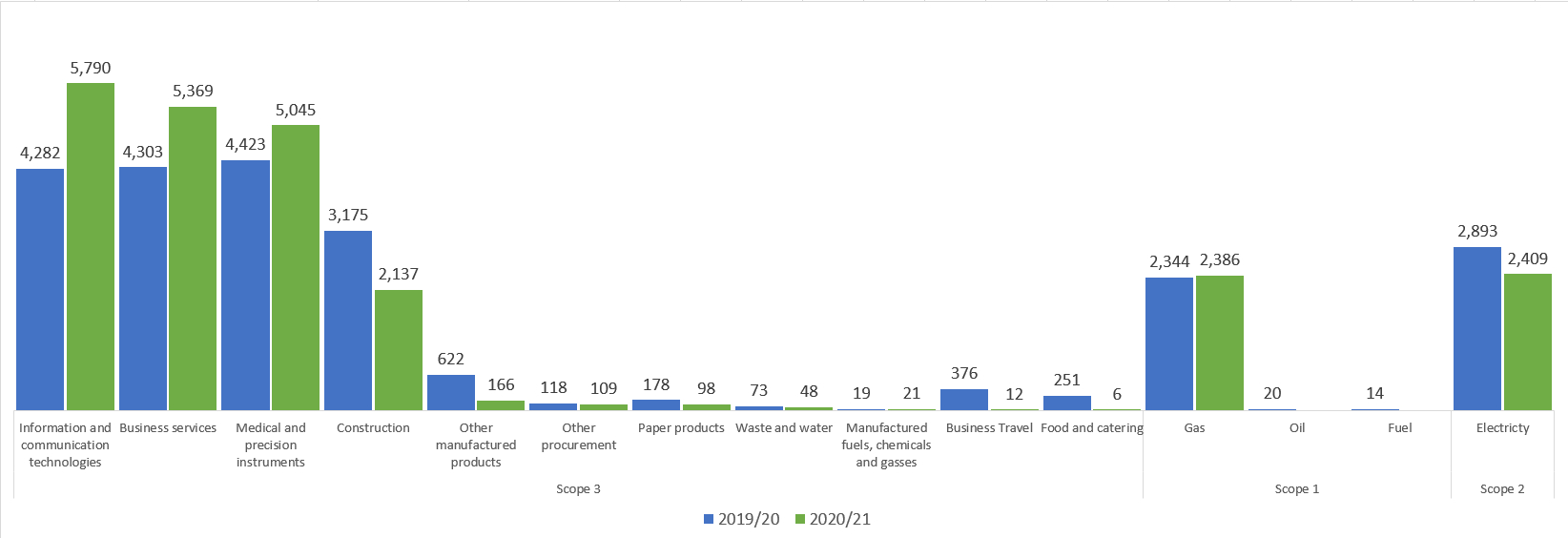The Carbon and Energy Reduction Officer provides expertise in the delivery of the University’s carbon management/energy conservation programme with the objective of reducing utilities expenditure and cutting carbon emissions within the context of Estates and Facilities, Property Services.
Carbon
Carbon Management
The University has previously achieved its target of reducing its operational carbon emissions by 30% by 2020/21 from a 2005/06 baseline. It is now actively working towards achieving Net-Zero carbon emissions for Scopes 1&2 by 2030.
In addition, the University is targeting Net-Zero Emissions for Scope 3 by 2045
What does this mean?
The University of Huddersfield is committed to responsible Carbon Management and will aim to increase energy efficiency and reduce carbon emission throughout all its direct operations (Scope 1&2) and supply chain (Scope 3).
The University has reduced its direct carbon emissions, achieving its previous 2020/21 target two years ahead of schedule. This was during a period in which it expanded in size with the construction of Student Central, Oastler Building, Barbara Hepworth Building, Joseph Priestley East, and the Sovereign Design House.
To achieve these targets the University has established the Carbon Emergency Steering Group, chaired by the Deputy-Vice Chancellor Prof. Tim Thornton, with representation from the Huddersfield Students Union, senior leaders, academic, and professional staff. This group provides the direction of travel and the mandate for the University to achieve its goals.
Energy
Whilst the national grid is decarbonising, it is still heavily reliant on fossil fuels, as is the University in providing heat through the combustion of natural gas. This is not sustainable and is damaging our planet, that’s why the University is working hard to reduce energy consumption and increase efficiency, whilst investing in renewable energy to generate power on campus.
What is the University doing?
Developing the University estate by designing any new buildings to be as energy efficient as possible with the use of natural resources such as daylight. Investing in future improvements in energy metering and energy data management systems for monitoring, targeting, and reporting. Investing to save in retrofit projects such as variable speed drives, boiler replacements, installing low-energy lighting, and plant replacement.
Renewable Energy Generation
In March 2022, the University completed Phase 1 of installing Solar Photovoltaic panels on the roof of the Laura Annie Willson Building to generate electricity. The 189.9kWp1 installed will generate an expected 150,000 kWh per year, the equivalent of forty average homes electricity consumption each year.
1. Kilowatt Peak (kWp) the unit of measurement for the theoretical maximum output of a solar photovoltaic system
 Laura Annie Willson Building Solar Photovoltaics (Phase 1)
Laura Annie Willson Building Solar Photovoltaics (Phase 1)Carbon Emissions Reporting
In addition to the Net-Zero emissions target, the University has also adopted an absolute emissions target for Scopes 1&2 in line with the Science Based Targets Initiative (SBTI) to consistently reduce emissions year on year to keep global warming temperatures below 1.5oc
The University has now adopted the Standardised Carbon Emissions Framework (SCEF), designed to align the measurement of carbon emissions across Higher and Further Education institutions.
The SCEF complies with GHG Protocol guidance on calculating and reporting, and the Streamlined Energy and Carbon Reporting (SECR) regulations. To comply with SECR the University publishes its preliminary carbon footprint figures each year within its Financial Statements
Definitions
Scope 1: emissions from sources directly owned or controlled by the University e.g., fuel used in vehicles, natural gas combusted to produce heat in buildings
Scope 2: generated by use of energy bought from a utility provider e.g., electricity from the national grid, heat provided from a third party
Scope 3: occurring from sources that the University does not own or control e.g., emissions associated with business travel, procurement, waste, and water
 University of Huddersfield carbon emissions (Scopes 1&2)
University of Huddersfield carbon emissions (Scopes 1&2)Scope 3 Emissions
This represents the largest source of emissions from the University's activities, and the hardest to manage due to them falling outside the organisations direct control. Included within Scope 3 are Business Travel, Goods and Services procured, construction, externally hosted ICT services, waste, and water management.
Scope 3 emissions can significantly vary year to year based upon both internal and external factors affecting the University e.g., the purchase of testing equipment and personal protective equipment (PPE) during the coronavirus pandemic led to an increase in associated emissions from Medical and Precision Instruments.
 Carbon emissions for Scopes 1,2&3 (Tonnes)
Carbon emissions for Scopes 1,2&3 (Tonnes)Environmental and Sustainability Policy
The University of Huddersfield is committed to the principles of environmental protection and sustainable development
Carbon Neutral Strategy
This strategy includes the targets and overarching approach to achieving Carbon neutrality as an institution
Net Zero Carbon Emissions Plan
This plan sets out the targets and principles on how the University will achieve its Net-Zero targets
How can you help?
Lighting
- Switch off lights that are not needed, even if you are just leaving the room for a few minutes. It’s a myth that switching fluorescent lights off then on again uses more electricity than leaving them on all the time.
- Make maximum use of daylight by opening blinds fully and switching off lights when natural light is bright enough.
- If possible don’t switch on all the lights when only a few are needed.
Computers and monitors
- Switch off your computer screen when leaving your desk for more than a couple of minutes
- Turn off your computer completely if you are leaving your desk for more than an hour, for example when you go for lunch or to a meeting.
- Screen savers do not save energy instead apply built in power saving settings. Set up your computer so that the screen goes on standby after 5 minutes
- After shutting down your computer, remember to turn off your monitor as well. Make sure the monitor power light is off – otherwise press the power button to ensure it is completely off.
- Contact IT support if you need assistance it.support@hud.ac.uk.
Electrical equipment
- Take responsibility for switching off printers and shared electrical equipment overnight and on weekends and holidays.
- For items that are not used every day, only switch on when needed then switch off straight away.
- Don’t leave appliances on standby - make sure they are powered down fully or switched off at the plug. Some appliances still use a quarter of their normal power in standby mode. Think TVs, and AV projectors and sound systems in lecture theatres.
- Avoid leaving mobile phones and laptops on charge unnecessarily. Unplug chargers when not in use, as they still consume power even when plugged in but not being used.
- Activate energy saving features on items like printers, photocopiers, and fax machines.
- Look for energy efficient equipment when purchasing.
- Switch fume cupboards off when they are not in use
Heating and cooling
- Dress for the weather
- Turn your radiators down before you open a window.
- Ensure radiators and heaters are not obstructed or covered by anything.
- If you think the heating or cooling is a problem in your area report it to the Estates Helpdesk at estates@hud.ac.uk or ext. 2550 as there may be a fault. Don’t just open windows.
- Please do not bring in and use your own portable electric heaters.
- Report windows and doors that do not seal correctly or if there are any cold draughts from windows or doors.
Around campus
- If you are able, take the stairs and not the lift
- Report any issues you see on campus to the Estates Helpdesk at estates@hud.ac.uk or ext. 2550 if you cannot resolve the situation yourself
Water
- Do not leave taps running after use
- Do not leave laboratory taps running after use
- Do not leave water running from equipment when not required
- If you spot a leak, a dripping tap or a constantly flushing urinal, report it as quickly as you can to the Estates Helpdesk at estates@hud.ac.uk or ext. 2550.
 The University's Carbon Management Plan ensures that the University is working towards goals 6, 7 and 9 of the United nations Sustainable Development Goals.
The University's Carbon Management Plan ensures that the University is working towards goals 6, 7 and 9 of the United nations Sustainable Development Goals.  The University's Carbon Management Plan ensures that the University is working towards goals 11, 12, and 13 of the United nations Sustainable Development Goals.
The University's Carbon Management Plan ensures that the University is working towards goals 11, 12, and 13 of the United nations Sustainable Development Goals. 